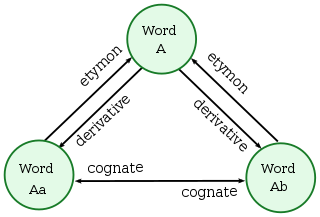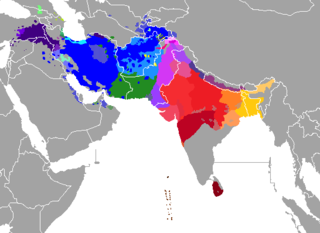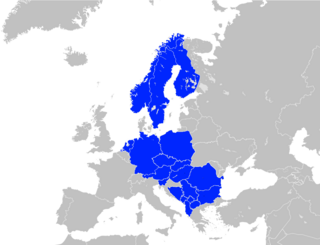Related Research Articles

Basque (; euskara, [eus̺ˈkaɾa]) is a language spoken by Basques and others of the Basque Country, a region that straddles the westernmost Pyrenees in adjacent parts of northern Spain and south-western France. Linguistically, Basque is a language isolate. The Basques are indigenous to, and primarily inhabit, the Basque Country. The Basque language is spoken by 28.4% (751,500) of Basques in all territories. Of these, 93.2% (700,300) are in the Spanish area of the Basque Country and the remaining 6.8% (51,200) are in the French portion.

In historical linguistics, cognates, also called lexical cognates, are sets of words in different languages that have been inherited in direct descent from an etymological ancestor in a common parent language. Because language change can have very radical effects on both the sound and the meaning of a word, cognates may not be obvious, and often it takes rigorous study of historical sources and the application of the comparative method to establish whether lexemes are cognate or not.
False cognates are pairs of words that seem to be cognates because of similar sounds and meaning, but have different etymologies; they can be within the same language or from different languages, even within the same family. For example, the English word dog and the Mbabaram word dog have exactly the same meaning and very similar pronunciations, but by complete coincidence. Likewise, English much and Spanish mucho came by their similar meanings via completely different Proto-Indo-European roots, and English "have" and Spanish "haber" are similar in meaning but come from different Proto-Indo-European roots. This is different from false friends, which are similar-sounding words with different meanings, but which may in fact be etymologically related.

The Indo-Iranian languages constitute the largest and southeasternmost extant branch of the Indo-European language family. They have more than 1.5 billion speakers, stretching from Europe (Romani), Kurdistan and the Caucasus (Ossetian) eastward to Xinjiang (Sarikoli) and Assam (Assamese), and south to Sri Lanka (Sinhala) and the Maldives (Maldivian), with branches stretching as far out as Oceania and the Caribbean for Fiji Hindi and Caribbean Hindustani respectively. Furthermore, there are large diaspora communities of Indo-Iranian speakers in northwestern Europe, North America, Australia, South Africa, and the Persian Gulf Region.
In linguistics and etymology, suppletion is traditionally understood as the use of one word as the inflected form of another word when the two words are not cognate. For those learning a language, suppletive forms will be seen as "irregular" or even "highly irregular".

Romani is an Indo-Aryan macrolanguage of the Romani communities. According to Ethnologue, seven varieties of Romani are divergent enough to be considered languages of their own. The largest of these are Vlax Romani, Balkan Romani (600,000), and Sinte Romani (300,000). Some Romani communities speak mixed languages based on the surrounding language with retained Romani-derived vocabulary – these are known by linguists as Para-Romani varieties, rather than dialects of the Romani language itself.
In linguistics, the Indo-European ablaut is a system of apophony in the Proto-Indo-European language (PIE).

The Thracian language is an extinct and poorly attested language, spoken in ancient times in Southeast Europe by the Thracians. The linguistic affinities of the Thracian language are poorly understood, but it is generally agreed that it was an Indo-European language with satem features.

Proto-Indo-European (PIE) is the reconstructed common ancestor of the Indo-European language family. Its proposed features have been derived by linguistic reconstruction from documented Indo-European languages. No direct record of Proto-Indo-European exists.
In etymology, two or more words in the same language are called doublets or etymological twins or twinlings when they have different phonological forms but the same etymological root. Often, but not always, the words entered the language through different routes. Given that the kinship between words that have the same root and the same meaning is fairly obvious, the term is mostly used to characterize pairs of words that have diverged at least somewhat in meaning. For example, English pyre and fire are doublets with merely associated meanings despite both descending ultimately from the same Proto-Indo-European (PIE) word *péh₂ur.

Spanish is a Romance language which developed from Vulgar Latin in central areas of the Iberian peninsula and has absorbed many loanwords from other Romance languages like French, Occitan, Catalan, Portuguese, and Italian. Spanish also has lexical influences from Arabic and from Paleohispanic languages such as Iberian, Celtiberian and Basque.
Caló is a language spoken by the Spanish and Portuguese Romani. It is a mixed language based on Romance grammar, with an adstratum of Romani lexical items through language shift by the Romani community. It is often used as an argot, a secret language for discreet communication amongst Iberian Romani. Catalan, Galician, Portuguese, and Spanish caló are closely related varieties that share a common root.
The term man and words derived from it can designate any or even all of the human race regardless of their sex or age. In traditional usage, man itself refers to the species or to humanity (mankind) as a whole.
Spasell is a slang of Insubric language, spoken until the 19th century by inhabitants of Vallassina, when they used to go out from the valley for business and they didn't want to be understood by the people. It is characterized by code-words conventionally defined basing on characteristics of the thing or on onomatopoeias; other words have an unknown origin. It has been noted by Carlo Mazza, vicar of Asso, in his book Memorie storiche della Vallassina of 1796. He informs us that several slangs have been created in the time, because in the time the words were introduced in the current language, reducing the differences between "official" language and "secret" language. After a list of terms, the vicar proposes, as example, the translation of Pater Noster in this language, evidencing that it's totally incomprehensible also by the Insubric speakers. There are various similar or identical slangs in many localities of Insubria, like Valtellina and Milan. Some Spasell words have been adsorbed by the common language, for example lòfi, used in northern Brianza to indicate a "so and so" person, or scabbi, used also by Carlo Porta in the poem Brindes de Meneghin a l'Ostaria to refer to wine, in alternation with vin.

El Chavo is a Mexican television sitcom created by Roberto Gómez Bolaños, produced by Televisa. It aired as an independent series on February 26, 1973 and finalized December 11, 1978. The series gained enormous popularity in Hispanic America, Brazil, Spain and other countries. The series theme song is a rendition of Ludwig van Beethoven's Turkish March, rearranged by Jean-Jacques Perrey & retitled “The Elephant Never Forgets”.

Albanian is an Indo-European language spoken by the Albanians in the Balkans and by the Albanian diaspora, which is generally concentrated in the Americas, Europe and Oceania. With about 7.5 million speakers, it comprises an independent branch within the Indo-European languages and is not closely related to any other Indo-European language.

Uropi is a constructed language which was created by Joël Landais, a French English teacher. Uropi is a synthesis of European languages, explicitly based on the common Indo-European roots and aims at being used as an international auxiliary language for Europe and thus contributing to building a European identity. Besides, given the spread of Indo-European languages outside Europe, it could be an international language for the world.
Sambahsa or Sambahsa-Mundialect is an international auxiliary language (IAL) devised by French linguist Olivier Simon. Among IALs it is categorized as a worldlang. It is based on the Proto-Indo-European language (PIE) and has a relatively complex grammar. The language was first released on the Internet in July 2007; prior to that, the creator claims to have worked on it for eight years. According to one of the rare academic studies addressing recent auxiliary languages, "Sambahsa has an extensive vocabulary and a large amount of learning and reference material".
References
- "Breve diccionario etimológico de la lengua española" by Guido Gómez de Silva ( ISBN 968-16-2812-8)